Exploring the World of Lasting Boutique Fashion Brands
Exploring the World of Lasting Boutique Fashion Brands
Blog Article
Sustainable Fashion: Exactly How Eco-Friendly Apparel Is Forming the Future of Design
As the garment industry faces boosting examination over its ecological influence, the surge of lasting style supplies an encouraging alternative that aligns style with ecological responsibility. Employing innovative materials such as plant-based textiles and recycled fibers, together with innovative approaches like electronic and 3D printing, developers are redefining what it suggests to be classy in the modern-day age. Simultaneously, the expanding appeal of upcycling and thrift culture is promoting a shift towards a circular economy. Just how does this motion really influence the future trajectory of fashion, and what obstacles exist ahead in its extensive adoption?
Cutting-edge Sustainable Products
As the garment industry comes to grips with its environmental impact, cutting-edge sustainable products have become an essential option for decreasing eco-friendly footprints. Amongst the most encouraging materials are those stemmed from all-natural, renewable sources, such as organic cotton, hemp, and bamboo. These products not only lower dependency on fossil gas however additionally reduce harmful chemical use and water usage. Organic cotton, for example, utilizes dramatically less water than standard cotton and eliminates the requirement for poisonous chemicals, thus maintaining soil health and wellness and biodiversity.
Along with plant-based products, innovations in biofabrication have actually led to the development of lab-grown textiles. Mycelium leather, acquired from mushroom origins, presents a biodegradable and versatile alternative to pet natural leather. Its manufacturing causes substantially reduced carbon discharges and water usage, making it a more sustainable choice for designer looking for to straighten with eco-friendly techniques.
Recycled products are likewise acquiring traction, with polyester made from recycled plastic containers standing for a substantial development. This advancement not only draws away plastic waste from oceans and landfills but additionally lowers power usage compared to generating virgin polyester. With each other, these materials underscore the possibility for a much more sustainable style market, paving the means for eco mindful design and production.
Eco-Conscious Production
Structure on the innovations in sustainable materials, the style market is also re-evaluating its production procedures to even more minimize environmental influence. Key methods consist of reducing water usage, lowering carbon emissions, and removing hazardous chemicals.
Another essential element is the decrease of harmful chemicals commonly used in dyeing and completing fabrics. Eco-conscious manufacturers are shifting towards plant-based dyes and waterless dyeing innovations, which not just guard local communities however additionally boost employee safety. Innovations like digital printing decrease material waste and energy usage, using a cleaner choice to typical approaches.
With the improvement of blockchain innovation, companies can currently give in-depth insights right into their supply chains, guaranteeing moral and eco friendly practices at each action. As the demand for eco-conscious items grows, manufacturers are urged to introduce, ensuring that the future of style is both elegant and sustainable.
The Surge of Upcycling
Upcycling, a transformative method in sustainable style, involves artistically repurposing discarded products into new, top quality items. This ingenious basics strategy not only lowers waste however also lessens the demand for raw products, thereby decreasing the environmental effect of clothing production. By reimagining and rebuilding existing products, developers and fashion brand names have the ability to infuse creativity right into their collections while promoting ecological duty.

In addition, the upcycling activity has empowered small companies and independent developers, that typically lead in innovation as a result of their dexterity and imagination. By profiting from the bountiful accessibility of unused products, these entities contribute to a round economic situation, demonstrating that style can be both elegant and sustainable. Via upcycling, the market takes significant strides in the direction of a more conscious and accountable future.
Thrift Society's Impact
The expanding thrift society considerably improves the landscape of sustainable style, emphasizing the relevance of mindful intake. This cultural shift urges consumers to welcome used apparel, thus find here lowering the demand for brand-new garment manufacturing and reducing ecological impact. Thrift purchasing not only prolongs the lifecycle of apparel but likewise decreases the carbon impact connected with production, transferring, and disposing of clothing.
A vital aspect of thrift society is its democratization of style. By offering a broad range of styles from numerous ages at inexpensive costs, second hand stores make style available to a more comprehensive audience. This ease of access cultivates a sense of uniqueness and imagination, as customers mix and suit unique pieces to curate customized wardrobes without contributing to the quick style cycle.
In addition, second hand society advertises circularity in style, straightening with the concepts of a round economic situation. By recirculating garments, the cycle of waste is disrupted, and resources are conserved. This practice sustains a change from a straight "take-make-dispose" version to an extra lasting structure. As more designers and consumers welcome second hand society, the apparel industry is obliged to adapt, integrating lasting techniques to fulfill the expanding demand for eco-conscious alternatives.

Future Trends in Fashion
Fashion's advancement is progressively shaped by sustainability-driven campaigns and technological developments. her latest blog One noticeable pattern is the rise of digital style, where digital garments can be worn in increased reality environments, dramatically reducing fabric waste.
Additionally, the combination of blockchain innovation supplies brand-new opportunities in openness and traceability, permitting consumers to verify the sustainability credentials of their clothes. boutique fashion. This makes sure responsibility in supply chains and advertises honest sourcing techniques. 3D printing is yet an additional technology that assures to revolutionize manufacturing procedures by making it possible for on-demand manufacturing, thereby reducing excess inventory and waste
As these innovations mature, they are positioned to change the fashion landscape, combining design with sustainability. The future of fashion, consequently, exists in a seamless mix of innovation, development, and ecological duty.
Final Thought
The transformation of the style market via sustainable methods shows a pivotal shift in the direction of ecological accountability. This advancement not just aligns fashion with eco-friendly sustainability but also establishes a precedent for future trends concentrated on duty and innovation.
As the fashion market encounters increasing scrutiny over its environmental effect, the surge of lasting fashion supplies an encouraging choice that aligns design with ecological responsibility.As the fashion market grapples with its ecological influence, cutting-edge sustainable materials have emerged as a vital remedy for lowering ecological footprints. Together, these materials underscore the potential for a more sustainable style sector, leading the means for environmentally conscious design and manufacturing.
Structure on the innovations in lasting products, the style sector is also re-evaluating its production procedures to better lower ecological effect. boutique fashion.Upcycling, a transformative method in sustainable fashion, involves artistically repurposing thrown out products into new, top quality products
Report this page